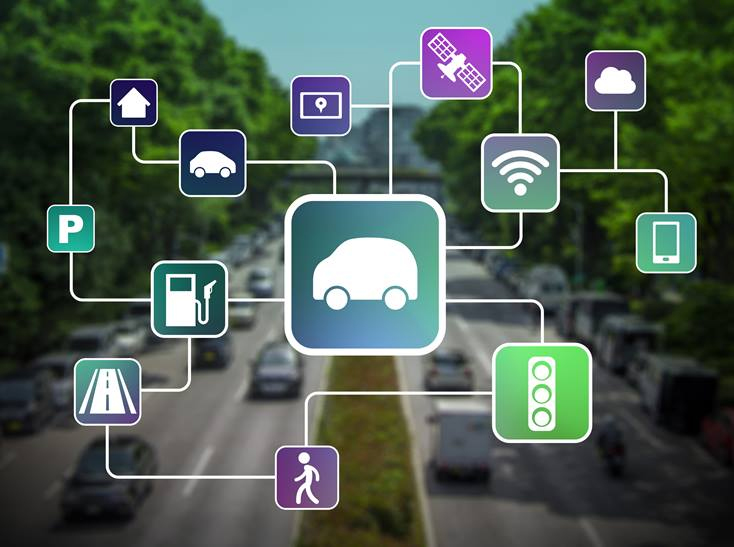Our modern life is closely connected to the network, and a connected car is one of the applications which demands prompt development. For the development of autonomous car, the first essential step will be to make cars smarter through the information communication, integration and interaction between internal devices via smart car system.
 A smarter, safer and more convenient vehicle
A smarter, safer and more convenient vehicle
The conventional automotive technology development usually puts more emphasis on speed, safety, comfort and energy-saving ability; however, the current focus has gradually shifted to the development of a smarter model that is capable of using new energy. The car, as a mobile device on the road, used to be a separate individual without any interaction with any external device. However, with the rapid development of mobile network, this barrier has been broken through and the vehicle is no longer simply an isolated device on the road. The remote control of a car, or even the communication between cars or car and device (such as traffic signals) is in the foreseeable future.
The communication between different cars involves various elements, and the varied cost-benefit consideration of automobile manufacturers and IT companies make it difficult for integration. Therefore, this technology is still at its early stage of development. On the other hand, the smart car system applied to specific cars has already entered the phase of contention with rapid progress. The so-called smart car system used to provide functions such as a CD player or car information display; with the rapid development of 3G, 4G and 5G technologies, this system has advanced to the era of IoT and been moving toward the realization of M2M (Machine to Machine). Hence, the smart car system is able to integrate separate AV and navigation systems, record during driving and active/passive safety system and provide a more comprehensive service for applications.
Currently, the main functions of CarPlay by Apple and Android Auto by Google still focus on the connection and interaction between cars and smartphones instead of the integration with the bottom-level control system, meaning both systems are surface-level human-machine interaction interfaces. In this article, we’ll introduce T-BOX, a smart car system with control and applications of a deeper level.
The main functions of T-BOX solution from Shenzhen Yeedon Media Co., Ltd include the new energy car monitor (mobile network) communication, car entertainment, safety and data collection. It can be used as a channel for network communication which connects and communicates with the service provider through the built-in SIM card. In addition, this solution can meet demands like safety and entertainment applications.
For safety, T-BOX communicates with BCM (Body Control Module) as an independent terminal in vehicle CAN network and receives the data from other terminals, including basic vehicle information, status and malfunction. In the meantime, it transmits remote control signals from the mobile network to the BCM and all related terminals to implement remote control of the vehicle.
As for communication capabilities, T-BOX communicates via mobile network; it transmits pre-defined in-vehicle network information to datacenter (cloud platform) and receives remote control signals and feedback from the network at the same time.
A car system has to address the demands of harsh environment and therefore the requirements for stability and quality is far severer. During the design stage, from component selection to production, the design, development and manufacture of T-BOX solution were aimed to fully address related automotive standards. The IPV54 rated structure and anti-tamper and waterproof features enable T-BOX to fully correspond to harsh driving environment. As for the software, the asymmetric encryption algorithm can not only ensure the safety of data transmission but also support remote upgrade.
Meanwhile, T-BOX solution supports services like I-CALL, B-CALL and E-CALL, and can also work with various mobile networks and support BDS and GPS to provide positioning service with high accuracy. Moreover, T-BOX supports the detection when vehicle collision or malfunction occurs and automatically uploads information; the support of USB 2.0 is helpful for scaling and data exchange of entertainment system.
The vehicle is capable of providing more services when integrated with smart car system as well as mobile network, such as voice browsing, emergency rescue, one touch SOS, online information (traffic and weather), remote monitor, network connection and traffic information, vehicle information upload, user behavior upload, information vehicle information upload (such as collision or malfunction), remote control command and remote upgrade. Drivers can benefit from the more convenient control integrated with various functions via the network, including vehicle positioning, maintenance notice, early warning of vehicle condition, speech recognition, remote control parking, remote payment, remote law enforcement, remote system management of vehicle information and remote control (such as heating, stalling and light flashing).
The smart car system is only the early stage of smart vehicle development. It is foreseeable that this system will be integrated with more technologies to achieve a smarter vehicle and gradually move toward the realization of an autonomous car, meaning current automotive technology will inevitably undergo essential changes. Let’s look forward to the day when those awesome automotive technologies in science fiction films come true!







